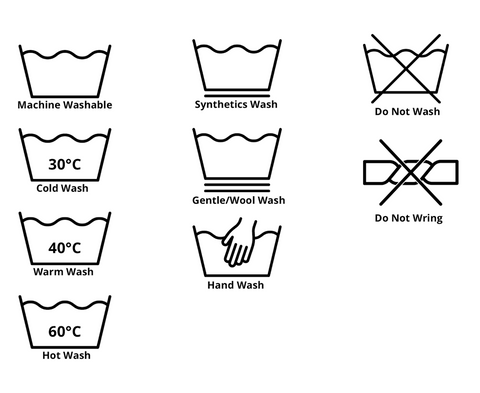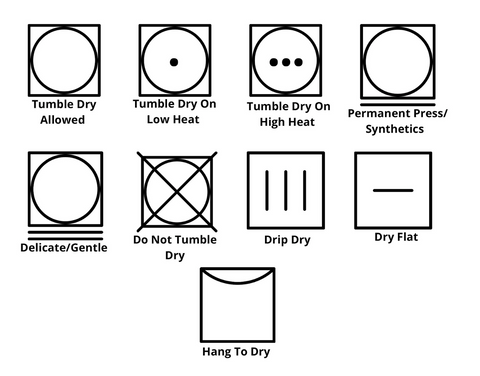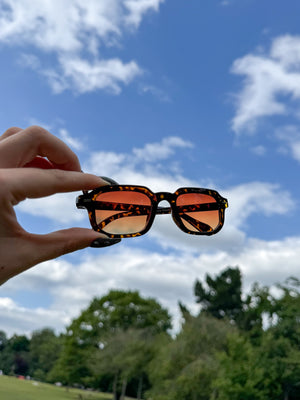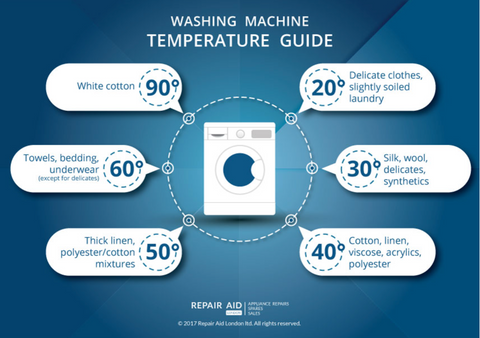
What Do The Symbols On Clothing Labels Mean?
Posted by Chrisia Borda on
Many of us ignore the labels inside of our clothing, or even cut them off for being irritating. But, should we be paying more attention to them? We throw our clothing into the wash at the same temperature and don’t consider that each item may have different requirements to ensure we aren’t damaging them or ruining their colour. So, what do these care labels really mean?
What are care labels?
Care labels are the small labels in clothing, often sewn into the bottom or size of a garment. These labels contain the guidelines about how to clean the item, how to care for the decoration, and what type of fabric the item is made from. Care labels can often suggest the temperature in which to wash each item, as well as whether to wash them separately, with other similar coloured items or even to hand wash them.
Why are these important?
Care labels are very important in terms of preventing damage in clothing. Manufacturers can receive complaints and customer returns due to the customer incorrectly cleaning the item and feeling it is therefore poor quality, which increases the amount of textiles going into landfill. This can be very costly for manufacturers and so it is very important for them to clearly state the washing instructions on their garments. Consumers are often persuaded to purchase an item if they can clearly see on the care label that the item will be easy to look after, and are often preferred to items that may be difficult to look after or that require dry cleaning.
What do the symbols mean?
Care labels have to be very small and so symbols are used to help consumers know how to care for each garment. These can be daunting at first if you are unsure what each symbol means, but they are really simple to understand.
Washing Symbols
These are the symbols used to know how an item should be washed, whether it should be hand washed or which temperature it should be washed at. If these symbols are not followed correctly, the fabric of the garment may shrink, or the colour of the fabric may run.
Most everyday items such as t-shirts, jeans etc are able to be machine washed at a medium temperature. Clothing made of lace or with decorative beading may have to be hand washed.

Bleaching Symbols
These are the symbols used to show us if an item can be bleached or not, or which bleach should be used. If these symbols are not followed correctly, the fabric may fall apart from the overuse of bleach, or it may change the colour of the item.
Chlorine bleach can be used on white clothing to remove stains or odours, but will remove the colour from any coloured fabrics and so shouldn’t be used for these. Instead, there are many stain removers available.

Drying Symbols
These symbols are used to show how an item should be dried, such as whether it should be hung to dry or whether it is able to go in the tumble dryer. If these symbols are not followed correctly, the fabric may be torn and therefore the clothing may be ruined.
Most of our everyday clothing can be put in the tumble dryer, like T-shirts, sweatshirts and jeans. However, clothing made of lace or silk is not recommended as it can become damaged or create very hard to remove wrinkles in the fabric. Instead, it is recommended to air dry these fabrics.

Ironing Symbols
These are the symbols used to show if an item can be ironed or not, and how hot it should be ironed. If these symbols aren’t followed correctly, the fabric may be burnt and even cause a whole in the fabric.
Most clothing made of cotton can be ironed with no problem, like shirts and trousers, but never iron materials such as leather or suede. These fabrics can be destroyed from the heat of the iron and therefore lose their texture. Instead, opt for steaming.

References
https://www.coats.com/en/information-hub/Care-Labels
https://www.ariel.co.uk/en-gb/how-to-wash/how-to-do-laundry/fabric-care-labels
https://www.circularonline.co.uk/news/uk-named-fourth-largest-textile-waste-producer-in-europe/
Imagery
https://images.app.goo.gl/R4nDgyxkLLHExFXy5
https://www.wovenlabelsuk.com/garment-labels/wl-05a.html
https://images.app.goo.gl/YQ4LrKW21Q7q5LHP9
https://images.app.goo.gl/jTVdue5iXeCjH4ft6
https://images.app.goo.gl/tZekC35t8Kp4hjLt9
Written By:
Katie Holman







